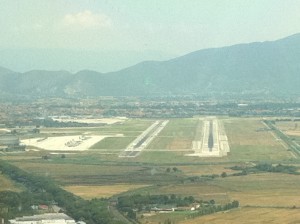Passenger Rights and the Law of Unintended Consequences
/https://tf-cmsv2-smithsonianmag-media.s3.amazonaws.com/filer/20111214013020IMG_0391.jpg)
I recently had an extensive delay on a flight from New York to Las Vegas. We pushed back from the gate on time, and as I went to start the engines I could see the dark skies to the west, our intended direction of flight. As we waited on the ramp for clearance to taxi, I heard the Ground Controller telling several planes to switch back to the Clearance Delivery frequency for a new route of flight. That’s never a good sign, and it tells us that certain departure routes are closed due to weather.
After being cleared to taxi to the end of a long line of planes, we were also told to switch radios to pick up a new clearance. Our intended departure fix, Robbinsville VOR, was shut down because of thunderstorms, and our new route would take us farther to the north. But the area of weather was extensive, and for a while it effectively shut down all departures from JFK Airport.
Heavy rain showers hit the airport and the line of planes remained stationary. We shut down our engines to save fuel, running our much less fuel-demanding APU (Auxiliary Power Unit) to provide electrical and air conditioning needs.
The delay was extensive, and we made several PAs to our passengers with updates on the weather and our (lack of) progress. In a situation like this, things can change quickly, and once the weather moves through the area, the controllers will get out the departures as fast as New York Center can handle them. We want to be ready to go when this happens.
Why am I going into so much detail about a delay that’s not all that uncommon? Because there’s a new wrinkle in the airline business, and it’s called The Passenger Bill of Rights. This bill became law this past Spring in response to some situations where passengers were essentially held hostage on an airplane for several hours. With the new law, an airline can be fined up to $27,500 per passenger if the airplane is on the ground for more than three hours without giving passengers an opportunity to deplane.
It sounds good on the face of it, but there are always some unintended consequences, and here’s how it affected us that evening. As we reached the two-hour point, we realized that another hour on the ground would make our company potentially liable for a fine approaching five million dollars. So we contacted our operations folks, and the decision was made to taxi back to the gate. The reason for making the decision at the two-hour point is that getting back to the gate would take some time since we had to get out of line and find an open route back to the terminal.
As it turned out, we got back to our ramp area after about 40 minutes of maneuvering by the ground controller to get other planes out of our way in this near-gridlock situation. Once on the ramp, we couldn’t park at the gate due to lightning — ramp personnel can’t come out when there’s lightning, for their own safety. With time running out on the three-hour limit, a mobile lounge was brought up to the plane so that a door could be opened and passengers could be given their legal right to deplane. We made it with eight minutes to spare.
Four or five passengers did take the opportunity to get off, and after getting some more fuel, we pushed back again with a fresh three-hour clock. The thunderstorm had passed and the airport was open, but the taxiways were still full of planes and it took nearly an hour before we even got cleared to taxi out from the ramp area.
As we approached the two-hour point again, we had a decision to make. Up ahead was a turn onto taxiway Foxtrot. Once we made that turn it would be next to impossible for us to get out of line and return to the gate. Not wanting to make a multi-million dollar decision on our own, we called our dispatcher (we’re allowed to use our phones on the ground for operational necessity). I explained the situation, including our position in line (number 19 or 20 for takeoff) and the departure rate (about one takeoff every two minutes). If we decided to return to the gate a second time, it would probably result in a flight cancellation, or at least the necessity to call out a fresh crew, which would probably take two hours or more.
The crew would get paid for the flight even if it cancelled, but pilots tend to be mission-oriented. Our dispatcher deferred to us, and we ultimately decided to take the gamble. We ended up taking off with 18 minutes to spare.
The bottom line is that because of our return to the gate, we experienced another two hour and 40 minute delay before getting airborne. With the additional time spent at the gate getting refueled, we took off nearly six hours late. Had we not returned to the gate, we probably would have shaved close to two hours off this.
So, the Passenger Bill of Rights may be great in concept (and was probably appreciated by the few who elected to get off our plane). But ironically, it can actually increase the delay that passengers experience. Our flight, which was scheduled to arrive in Las Vegas at 8:40 P.M. made it to the gate at 2:55 A.M. I was fresh as a daisy…the topic of an upcoming blog.
And now for something completely different: as promised earlier, here’s a picture of another airport’s runways. Can you name the airport? Hint: it’s not in the U.S.
The di
Planning Your Next Trip?
Explore great travel deals
Smithsonian magazine participates in affiliate link advertising programs. If you purchase an item through these links, we receive a commission.
